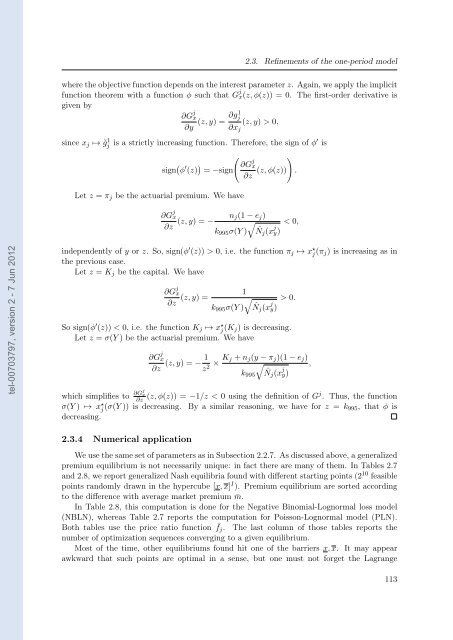Etude des marchés d'assurance non-vie à l'aide d'équilibres de ...
Etude des marchés d'assurance non-vie à l'aide d'équilibres de ...
Etude des marchés d'assurance non-vie à l'aide d'équilibres de ...
You also want an ePaper? Increase the reach of your titles
YUMPU automatically turns print PDFs into web optimized ePapers that Google loves.
tel-00703797, version 2 - 7 Jun 2012<br />
2.3. Refinements of the one-period mo<strong>de</strong>l<br />
where the objective function <strong>de</strong>pends on the interest parameter z. Again, we apply the implicit<br />
function theorem with a function φ such that G j x(z, φ(z)) = 0. The first-or<strong>de</strong>r <strong>de</strong>rivative is<br />
given by<br />
∂G j x<br />
∂y (z, y) = ∂g1 j<br />
(z, y) > 0,<br />
∂xj<br />
since xj ↦→ ˜g 1 j is a strictly increasing function. Therefore, the sign of φ′ is<br />
sign φ ′ (z) = −sign<br />
Let z = πj be the actuarial premium. We have<br />
∂G j x<br />
∂z<br />
<br />
∂G j x<br />
(z, φ(z))<br />
∂z<br />
<br />
nj(1 − ej)<br />
(z, y) = − <br />
k995σ(Y ) ˆNj(x j < 0,<br />
y)<br />
in<strong>de</strong>pen<strong>de</strong>ntly of y or z. So, sign(φ ′ (z)) > 0, i.e. the function πj ↦→ x ⋆ j (πj) is increasing as in<br />
the previous case.<br />
Let z = Kj be the capital. We have<br />
∂G j x<br />
(z, y) =<br />
∂z<br />
1<br />
<br />
k995σ(Y ) ˆNj(x j > 0.<br />
y)<br />
So sign(φ ′ (z)) < 0, i.e. the function Kj ↦→ x ⋆ j (Kj) is <strong>de</strong>creasing.<br />
Let z = σ(Y ) be the actuarial premium. We have<br />
∂G j x 1<br />
(z, y) = −<br />
∂z<br />
z2 × Kj + nj(y − πj)(1 − ej)<br />
<br />
k995<br />
ˆNj(x j y)<br />
which simplifies to ∂Gj x<br />
∂z (z, φ(z)) = −1/z < 0 using the <strong>de</strong>finition of Gj . Thus, the function<br />
σ(Y ) ↦→ x ⋆ j (σ(Y )) is <strong>de</strong>creasing. By a similar reasoning, we have for z = k995, that φ is<br />
<strong>de</strong>creasing.<br />
2.3.4 Numerical application<br />
We use the same set of parameters as in Subsection 2.2.7. As discussed above, a generalized<br />
premium equilibrium is not necessarily unique: in fact there are many of them. In Tables 2.7<br />
and 2.8, we report generalized Nash equilibria found with different starting points (2 10 feasible<br />
points randomly drawn in the hypercube [x, x] I ). Premium equilibrium are sorted according<br />
to the difference with average market premium ¯m.<br />
In Table 2.8, this computation is done for the Negative Binomial-Lognormal loss mo<strong>de</strong>l<br />
(NBLN), whereas Table 2.7 reports the computation for Poisson-Lognormal mo<strong>de</strong>l (PLN).<br />
Both tables use the price ratio function ¯ fj. The last column of those tables reports the<br />
number of optimization sequences converging to a given equilibrium.<br />
Most of the time, other equilibriums found hit one of the barriers x, x. It may appear<br />
awkward that such points are optimal in a sense, but one must not forget the Lagrange<br />
.<br />
,<br />
113
















